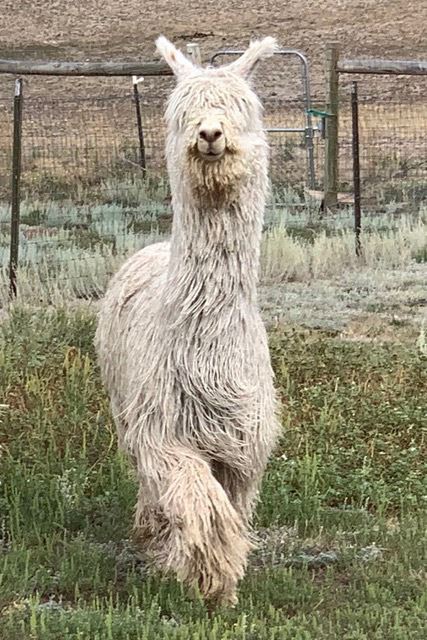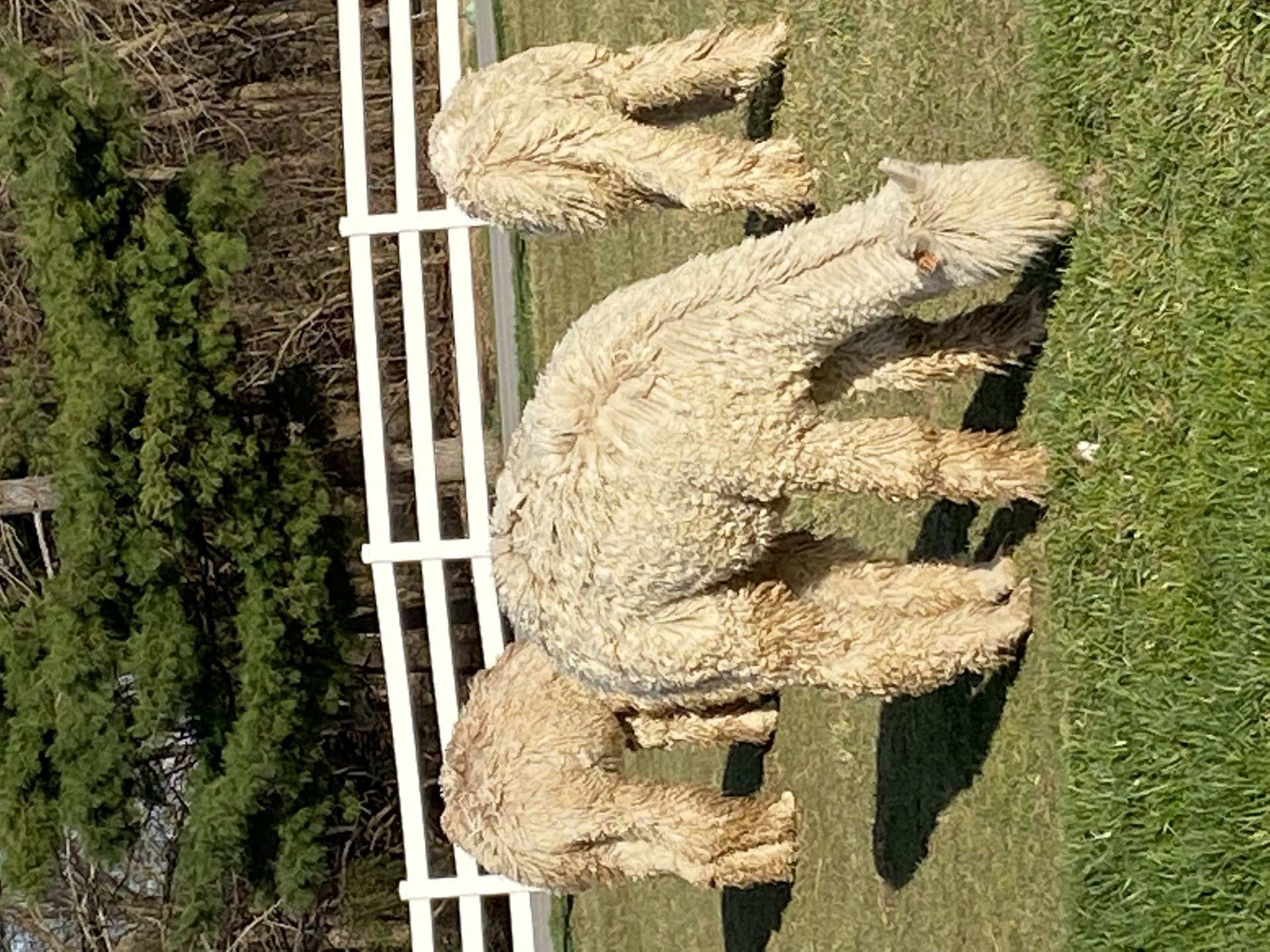MORE ABOUT SURIS |
Suri Alpacas are members of the camel (camelid) family of South America. Their ancestors originated on the central plains of North America about 10 Today’s Camelid family includes the 2 humped bactrian camel of Asia, the dromedary camel of the Mid-east and Africa, and the New World Camelids in South America- the guanaco, the llama, the alpaca, and the vicuna. Of the New World Camel family, only the alpaca and the llama are domesticated, although annually there are roundups of vicuna called chacus where the vicuna are shorn for their fleece. The fiber harvested from these vicunas is the finest and most valuable animal fiber in the world.
South American alpaca husbandry reached its zenith in the 11th and 12th centuries A.D. under the Inca Empire. During the 16th century, when the Spanish conquered Peru, the alpaca was viewed as an inferior animal to the Spanish sheep and cattle, driven from its pedestal in the Incan Empire, and sent to the higher elevations of Bolivia and Peru known as the "altiplano” (high plains). This area is above 14,000 feet elevation and is a very harsh environment, but the alpaca adapted amazingly well, and did survive, but due to the limited vegetation and husbandry practices (and also their slaughter by the Spanish), the numbers of alpacas remained relatively small. According to some sources, today there are over 3.5 million alpacas in Peru (roughly 90% of the world resource). The United States had its first importation of alpacas from Chile in 1983, another in 1984, and an additional importation in 1988. In 1991 we received our first importation from Peru. Subsequent importations and breeding has grown the United States alpaca herd tremendously. As of 2017, we have over 200,000 alpacas in the Alpaca Owners Association Registry. There are also large populations of alpacas in Australia and Canada and smaller numbers in Great Britain, Europe, New Zealand, and southern Africa. | Who Owns Suri Alpacas?
One of the most interesting things about our North American alpaca industry is the diversity of the people that own them. Suri alpacas' smaller size, gentle nature, and ease of care make them popular with both young and old. Many owners had little or no experience with livestock before owning alpacas, while some come from extensive agricultural backgrounds. Alpacas are a great choice of livestock for the family. Children as young as 4 can handle a well-trained alpaca with an adult’s assistance. Their fleece is attractive to those who enjoy the fiber arts, and going to alpaca shows and competing can be great fun for all ages. How Long Do Suri Alpacas Live? Suri alpacas live between 15 to 20 years. The longest documented lifespan is 27 years.
Are Suri Alpacas Easy to Breed and Do They Give Birth Easily? Suri alpacas usually are bred at 18 months of age or older. Usually a specific herdsire is brought to the female, but some farms will turn one herdsire out into a field with a group of females to mate over a week or two. Gestation or pregnancy takes approximately 345 days. In most cases, crias (alpaca babies) are born without intervention, and usually during the first half of the daylight hours. Normally a cria weighs between 15 and 19 pounds and will be standing and nursing within 90 minutes of birth. The cria continues to nurse for about six months until it is weaned from its mother. OUR RESOURCE PAGE IS LOADED WITH LINKS TO ADDITIONAL INFORMATION ABOUT SURI ALPACAS |
Is It Okay to Have Just One Alpaca?
As a general rule, the answer is no. Alpacas have very strong herding instincts and need the companionship of other alpacas to thrive. Gender-appropriate (or neutered) llamas sometimes will successfully bond with an alpaca. Otherwise, it is best to provide each alpaca with at least one companion alpaca of the same gender.
Where Are Suri Alpacas Raised?
Suri alpacas now reside all over North America from Florida to Quebec, and from Alaska to Maryland. Suris are amazingly resilient animals and have adapted successfully to the extremes of both hot and cold climates. In hot, humid climates, alpaca owners take extra precautions to make sure that the alpacas do not suffer from heat stress. These precautions include: shearing fleeces early each year, providing shade, running fans and enhancing ventilation in the barn, offering cool fresh water for drinking, and hosing off their bellies (where heat is dissipated) on very hot days. In harsher cold climates, adequate shelter must be provided that allows alpacas to escape from wind and rain or snow.
year, providing shade, running fans and enhancing ventilation in the barn, offering cool fresh water for drinking, and hosing off their bellies (where heat is dissipated) on very hot days. In harsher cold climates, adequate shelter must be provided that allows alpacas to escape from wind and rain or snow.
Relative to other livestock, Suri alpacas are easy to care for. They require clean, fresh water, adequate pasture or hay, minerals, and shelter that will protect them from extremes in the weather. Some choose to provide additional food supplements in the form of grain or pellet.
Because these animals are environmentally friendly and require so little pasture and food, you can usually raise from two to eight alpacas on an acre of land, depending on terrain, rain/snowfall amounts, availability of pasture, access to fresh water, etc. They can also be raised on a dry lot and fed grass hay.
Because their only defense is to kick or spit, alpacas require sound fencing to keep predators such as coyotes, wolves, and dogs out of their pastures. In extreme weather locations that are very hot or very cold, extra care may be required to keep them comfortable.
What Noise Do Suri Alpacas Make?Alpacas are very quiet, docile animals that make a minimal amount of sound. They make a pleasant humming sound as a means of communication or to express concern or stress. Occasionally you will hear a shrill sound, called an "alarm call," which usually means they are frightened or angry with another alpaca. Male alpacas also "serenade" females during breeding with a guttural, throaty sound called "orgling."
Are Suri Alpacas Clean Animals? Yes, they are much cleaner than most livestock. Alpacas have minimal aroma and tend to attract less flies in the summertime than other forms of livestock. Furthermore, alpacas often defecate in communal dung piles. There may be three or four of these areas in a pasture, spread throughout about 10% to 20% of the pasture. This makes for easy clean-up, reduced opportunity for parasites, and better overall hygiene in the herd. TO FIND A SURI ALPACA FARM OR RANCH TO VISIT, | Are Suri Alpacas Easy to Train? Alpacas are very smart animals and are fairly easy to train. It is best to start training them when they are young so that they will accept a halter and learn to follow on a lead. Many owners also enjoy training them to walk through obstacles; some even compete with their alpacas at shows where they walk over, through, and around objects, and also jump over small hurdles. Also, it is helpful to train alpacas to ride in a trailer or van if they ever need to be transported to a show or another farm. Alpacas are easy to transport, as they normally cush (lay down with their legs folded under them) when traveling. |
 million years ago. These llama-like ancestors migrated south to what is now South America and evolved into primitive examples of today’s Guanaco and Vicuna. By the end of the last ice age (10,000-12,000 years ago), Camelids no longer existed in North America. It is believed that alpacas were domesticated from the wild vicuna in the Andean highlands of Peru about 7,000 years ago, and they are among the oldest domestic animals in the world. Suri alpacas are found in South America in Ecuador, Bolivia, Peru, and Chile west of the Andes Mountains.
million years ago. These llama-like ancestors migrated south to what is now South America and evolved into primitive examples of today’s Guanaco and Vicuna. By the end of the last ice age (10,000-12,000 years ago), Camelids no longer existed in North America. It is believed that alpacas were domesticated from the wild vicuna in the Andean highlands of Peru about 7,000 years ago, and they are among the oldest domestic animals in the world. Suri alpacas are found in South America in Ecuador, Bolivia, Peru, and Chile west of the Andes Mountains. For thousands of years the Suri alpaca was intensively selected and bred by the Inca for their fleeces of abundant, fine fiber. The alpaca was involved in every aspect of the Andean civilization. Besides providing fleeces for warm, luxurious clothing, they were also used for meat, hides, and as religious symbols. Even their dung was collected and used for fires in peasant homes.
For thousands of years the Suri alpaca was intensively selected and bred by the Inca for their fleeces of abundant, fine fiber. The alpaca was involved in every aspect of the Andean civilization. Besides providing fleeces for warm, luxurious clothing, they were also used for meat, hides, and as religious symbols. Even their dung was collected and used for fires in peasant homes.